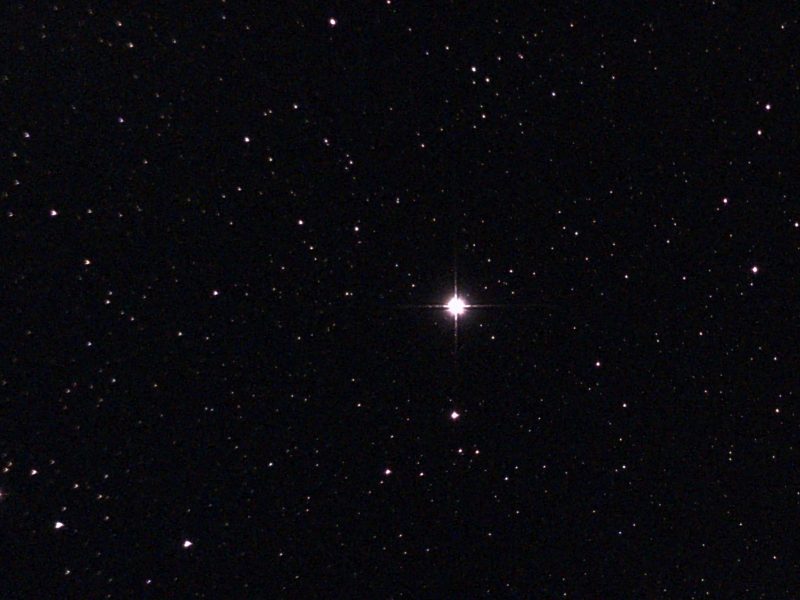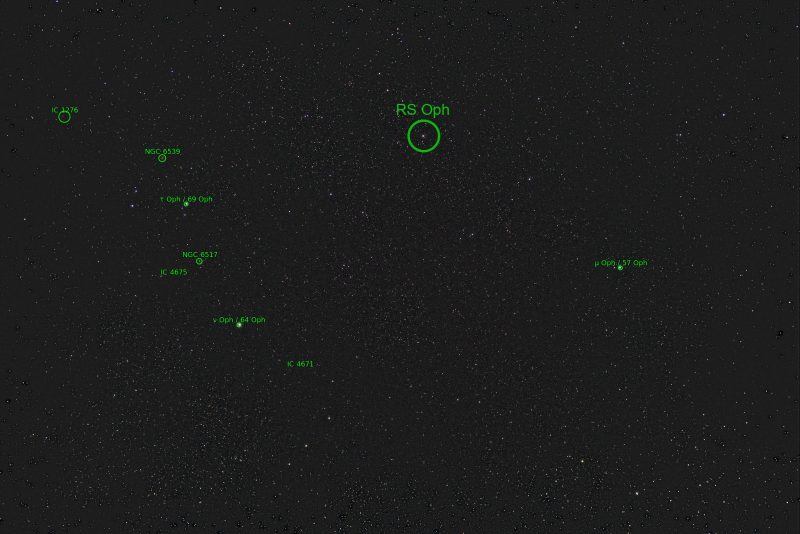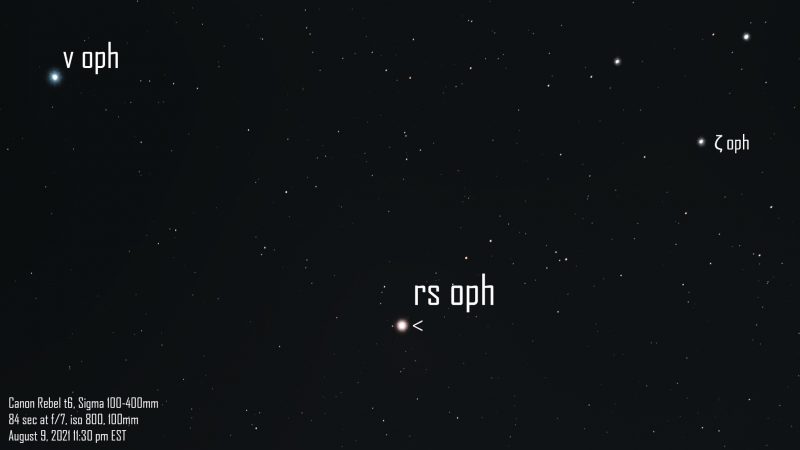
A rare nova visible to the eye
On August 8, 2021, the star RS Ophiuchi burst into view in Earth’s sky as what astronomers call a nova. It’s a rare nova visible to the unaided eye. It’s nowhere near as bright as the brightest stars. But, in a dark sky, you can see it shining in the constellation Ophiuchus the Serpent Bearer. Earlier this week, the nova was said to have brightened to magnitude 4.3. If true, that would be huge amount of brightness increase for this star. RS Oph normally shines at around a magnitude of 12. It’s usually much too dim to see with the eye or even most backyard telescopes. But a sudden thermonuclear explosion on this star’s surface has increased its brightness several hundredfold.
This isn’t the first time RS Oph has gone nova. RS Oph is part of a recurrent nova star system. That is, the system has regular explosions. RS Oph is part of a two-star system. One is a white dwarf, a highly compact, evolved star. The other is a red giant. The explosions happen when the white dwarf accretes or pulls too much mass from its red giant companion. The excess mass triggers a thermonuclear explosion in a hydrogen layer on the white dwarf’s surface. You might see that this can happen periodically, as the two stars orbit each other, and one keeps pulling from the other. The system’s most recent nova was in 2006, but known explosions of the star go back to 1898.
The explosions of RS Oph are spaced out approximately every 15 years. That means we can expect a future nova from RS Oph too. A system like RS Oph – whose outbursts recur on the order of decades – are rare. So the current outburst of this star is a special treat.

An impressive sight of a very rare occurrence in our galaxy – only 10 are known.” Thank you, Greg!
How to find RS Ophiuchi
The nova brightened this week, but now may be beginning to fade. Over the past day yesterday (August 10, 2021), we didn’t see any brightness estimates from the American Association of Variable Star Observers any brighter than 5th magnitude. That’s still within the limit of seeing it with the eye alone, but just barely. See it while you can.
The constellation Ophiuchus is currently in the south after sunset. It lies above the better-known constellation Sagittarius and its familiar Teapot asterism, which is closer to the horizon. If you look above the spout of the Teapot and cross the cloudy swath of the Milky Way, you’ll come to the region of sky where RS Oph lies.

The brightest star in Ophiuchus is Rasalhague, located near the top of the constellation, and the second-brightest is Sabik, located near the bottom. RS Oph lies about midway between the two stars but farther to the left (east). You can use the photo above as a star chart to get you to the right area, then use the photo below to narrow down the field. You can also find a star chart at SpaceWeather.com.

Observer reports of RS Oph
Observers took to Twitter to share their reports of RS Oph.
…just been out and took a snap of RS Oph on my phone ? (saw a nice Perseid meteor too) pic.twitter.com/EYGc37tsp2
— Tim O'Brien (@ProfTimOB) August 9, 2021
The eruption of the recurrent nova RS Oph making its grand appearance in our ASAS-SN images following its outburst two nights ago! pic.twitter.com/kVIcOZhIbq
— Michael Rizzo Smith (@MikeRizzoSmith) August 10, 2021
Yesterday, the variable star RS Oph in the constellation Ophiuchus exploded. Although it is 5000 light years away, the blast is bright enough to see with the unaided eye after sunset. Use a tool like https://t.co/BEwCxuZkKz to find RS Oph from your location. pic.twitter.com/xmKO8c6Xmp
— Cook Planetarium (@CookPlanetarium) August 9, 2021
RS Oph is in eruption at 4.5 mag now!! Please observe!#NovaEruption #RSOph #citizenscience #telescopes #citizenscience pic.twitter.com/im0s93XgDa
— Dr. Stella Kafka (@stellakafka) August 9, 2021
Bottom line: RS Ophiuchi is a stellar system that undergoes recurrent novas, and on August 8, 2021, a nova appeared to observers with the unaided eye. Is it still visible? The only way to know is to look.











